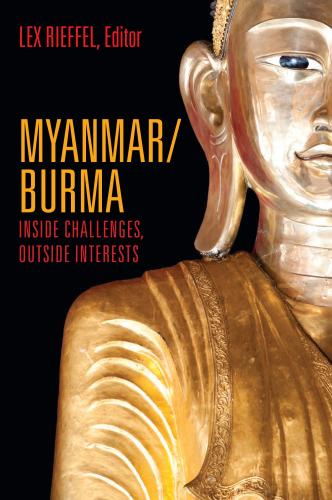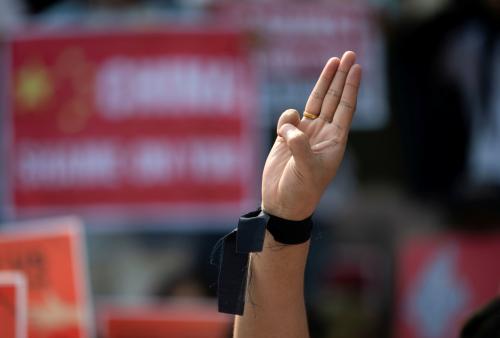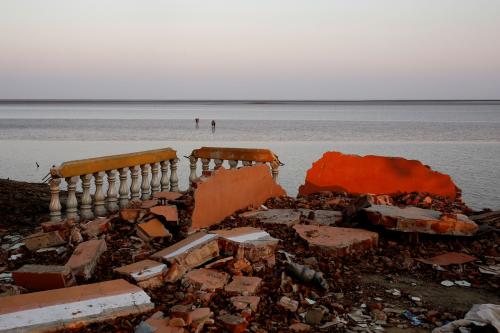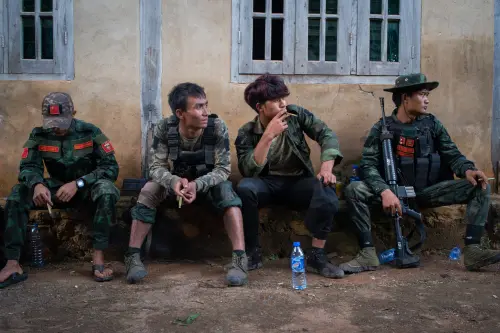This piece is part of a series titled “Nonstate armed actors and illicit economies in 2022” from Brookings’s Initiative on Nonstate Armed Actors.
Among people who work on Myanmar, there is a politically incorrect but popular saying: “When there are three Burmese, there are four opinions.” Terrible as it may sound, it gives a flavor of the profound diversity, and therefore division of interests and views, that has long marked the norm in the country. Despite the urgent and unprecedented need for unity after the February coup last year, the old and the new resistance to the military government have not yet been able to find a common path despite the presence of a common cause. Instead, the factionalization within the oppositions that had plagued the national reconciliation process for decades before the coup continues to affect the modality and the effectiveness of the opposition today.
The new players: The National Unity Government and the People’s Defense Force
Following the February 1 coup last year, a group of members of parliament elected in 2020 formed the National Unity Government (NUG) on April 16. The ruling military junta’s State Administration Council (SAC) promptly declared the NUG illegal and a terrorist organization. The NUG announced the establishment of the People’s Defense Force (PDF) in May and declared a “people’s defensive war” against the military government in September. Internationally, the NUG has self-claimed to be the sole legitimate government representing Myanmar and has demanded diplomatic recognition from sovereign governments without success.
By the last quarter of 2021, all members of the NUG had left Myanmar and gone into exile. The People’s Defense Force, however, has become a grassroots-level insurgency, with organized local branches operating in small pockets of territories across the nation, especially in the ethnic states (Burma is divided into seven regions dominated by the Bamar ethnic majority and seven states inhabited primarily by ethnic minorities). Despite the broad representation the NUG and the PDF claim, the caveat is that not all local armed groups are part of the PDF — they might share the PDF’s aspirations but are unwilling to accept its command. And not all branches nominally under the PDF are under the control of NUG — despite the nominal command structure, they enjoy de facto independence and autonomy in their operations.
This evidently creates many questions about the insurgency, especially its decisionmaking authorities and the representativeness of any declaratory policy. For example, in November, three former peace negotiators known for their proximity to the Myanmar military claimed that they had been put on a “hit list” created by the NUG and PDF. Experts and policy practitioners who work on the matter know that such a list indeed exists, especially considering that urban campaigns of assassination against junta members and bombings have been taking place in Myanmar’s cities. But regarding the assassination plan for the trio, the question is who created it — the NUG, the PDF, or people associated with either or both of them. The NUG has denied that it has such a list, but the hydra-headed nature of the resistance force has complicated the determination. The proliferation of actors might offer the NUG and the PDF deniability, but it undermines their authority and reputation at the same time.
The old complications: Ethnic armed organizations
The resistance campaign is further complicated by the ethnic factors of the country. During the pseudo-democratic period under the presidency of Thein Sein (2011-2016), the ethnic armed organizations (EAOs) in Myanmar roughly self-divided into two camps: signatories and non-signatories of the Nationwide Ceasefire Accord (NCA) negotiated in 2015 by the central government. The non-signatories are from the north, especially those along the Chinese border. These groups, especially the United Wa State Army (UWSA) and its proxies, as well as the Kachin Independence Army, boast larger forces and financial resources and chose to hold out for a better deal later. The signatories are smaller EAOs located further south, in lower Myanmar. They accepted the NCA because it was seen as the best deal that they could get given their weaker material and military position.
These factors also affect the two camps’ attitude toward the military junta after the coup. Key NCA signatories, such as the Restoration Council of Shan State and the Karen National Union, moved quickly to condemn the military coup. The truce was quickly broken and fighting reignited. But the non-signatories have been much less committal. Key players such as the UWSA have been sitting on the wall without either accepting or condemning the military coup. This is understandable given that these groups have enjoyed higher level of autonomy and operating outside the authority of the Burmese central government regardless of who is in control. For them, as long as the cease-fire is maintained, the chaos in Myanmar on the national level only creates more breathing room for them.
Outside the signatories and non-signatories, there are also three organizations — the Arakan Army, the Ta’ang National Liberation Army, and the Myanmar National Democratic Alliance Army — that have been engaged in active fighting with the Burmese military for the past decades. They were denied a seat at the negotiation table because they were seen as having formed after the peace process started in 2011. As a third category, they naturally align more with the non-signatories.
When the old meets the new
While the diversity of views among EAOs has been complicated enough, the relationship between NUG/PDF and the EAOs further complicate the picture. The EAOs have been engaged in armed insurgency against the Burmese central government for seven decades. In comparison, the democratic opposition, represented by the National League for Democracy led by Aung San Suu Kyi, had historically adopted a nonviolent political rather than military approach to the struggle with the junta. Now the NUG/PDF has embarked on the path of armed resistance, it is only natural for them to seek alliance and assistance from the EAOs, especially arms, shelter, and training. In fact, many PDF militias have received such assistance from the ethnic organizations.
However, the ethnic groups’ views of the NUG and PDF also vary. Needless to say, some EAOs have been inspired by the resistance campaign after the coup and have provided training and weapons as well as coordinated operations with the PDF. However, that is only part of the story. In the views of some ethnic groups, the military coup is essentially an intra-Bamar civil-military contest for power, as the Burmese military and National League for Democracy are both predominantly ethnic Bamar, and the ethnic groups have been denied power sharing under the reigns of both. The argument is strengthened by the reality that the NUG is also Bamar-centric. Although it has included some ethnic representatives in its Cabinet, none are ethnic Shan even though Shan make up 9% of the country’s population and predominate in a fifth of its territory. Furthermore, some EAOs are aggrieved by the NUG/PDF refusal to accommodate their political aspirations — despite the NUG and the PDF’s need for assistance from the ethnic groups, they have rejected a new constitution or constitutional framework proposed by the ethnic groups to better include them in the future government of Myanmar.
Divided they fall
The consequence of all the profound divisions and self-serving calculus is the undermining of the unity required for an effective resistance campaign against the military junta. Yet the rifts are a reflection of the diverse historical background and ethnic composition of the nation, as well as the different aspirations and negotiating positions of various resistance groups. There is no easy solution to the factionalization of the resistance, as none of the groups appear strong enough — politically, morally, or financially — to absorb and unify other groups under its wing.
This is bad news for the resistance. While the oppositions are divided, the Burmese military is a highly unitary, monolithic, and hierarchical organization. The military has tried to keep the resistance divided by keeping the dialogues open with the EAOs in the north in order to prevent them from aligning with the PDF. On the battlefield, the military has run a counterinsurgency campaign against the PDF, including specialized units, scorched earth tactics, militarized police, and mass surveillance. This does not mean that the military can easily conquer the resistance and defeat the insurgency. The past seven decades show the low likelihood of that happening. But it does mean that the resistance has a long way to go before it could effectively match and counter, let alone defeat, the military.
The Brookings Institution is committed to quality, independence, and impact.
We are supported by a diverse array of funders. In line with our values and policies, each Brookings publication represents the sole views of its author(s).











Commentary
One year after Myanmar’s coup, old and new resistance is undermined by divisions
February 1, 2022